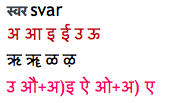Thoughts Without Words: Transit to Linguistic Form
Thoughts Without Words: Transit to Linguistic Form
It was only when I started relearning Sanskrit as an adult that I gradually became aware of the passage to linguistic form/space. Learning Sanskrit in school had been a gymnastics of mental memory – both acoustic and visual – mathematical tables of roots with endings – a series of woven patterns. Unlike Latin and Germanic languages, Sanskrit syntax is flexible. There is neither a fixed subject – verb- object nor redundant articles & prepositions. Instead there are roots with different prefixes and endings which give them verbal or noun case functions. Thus कृ kri = do/act/ verb, कृति kriti-creation noun. आकार /Aakaar –form.



